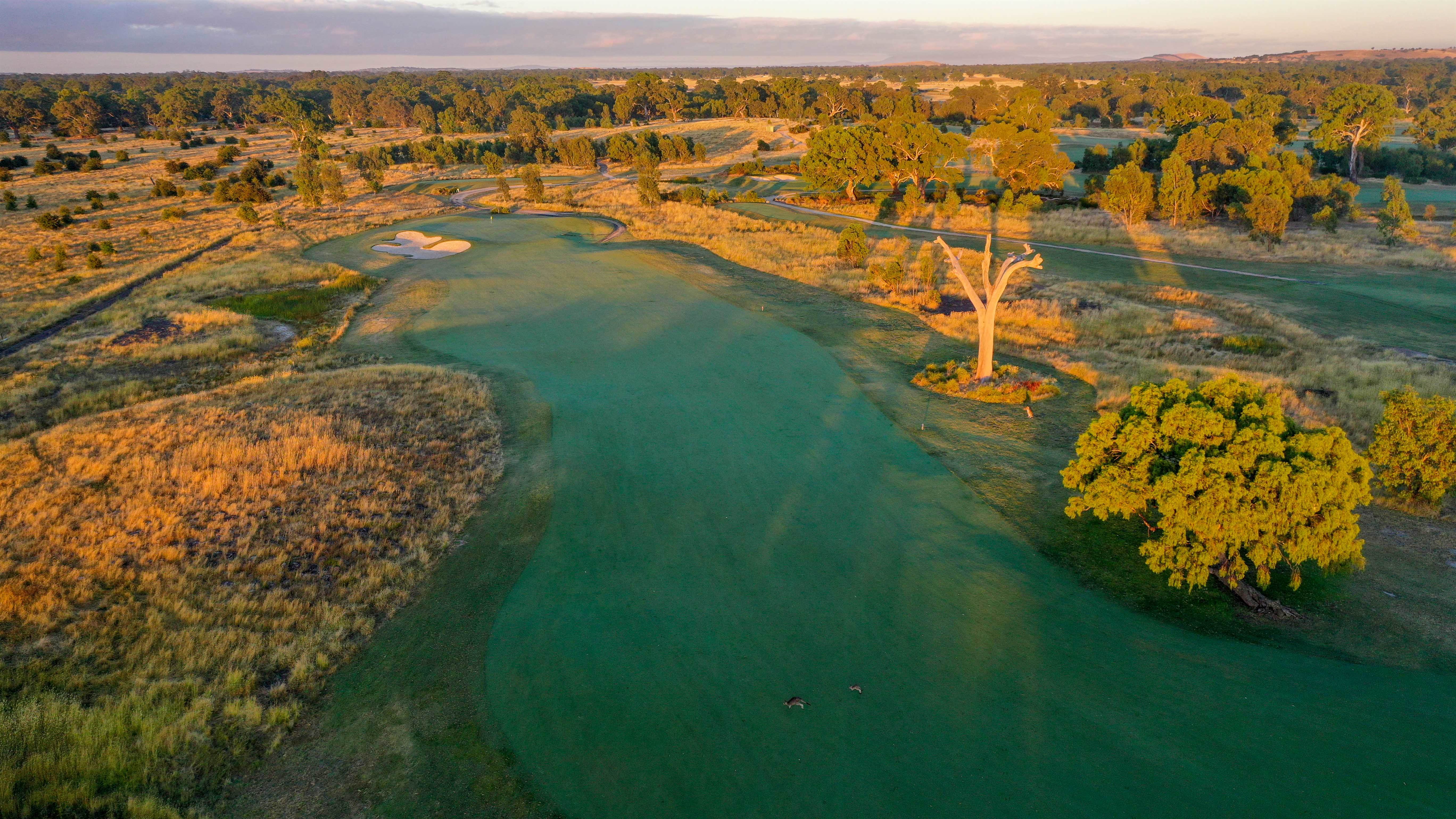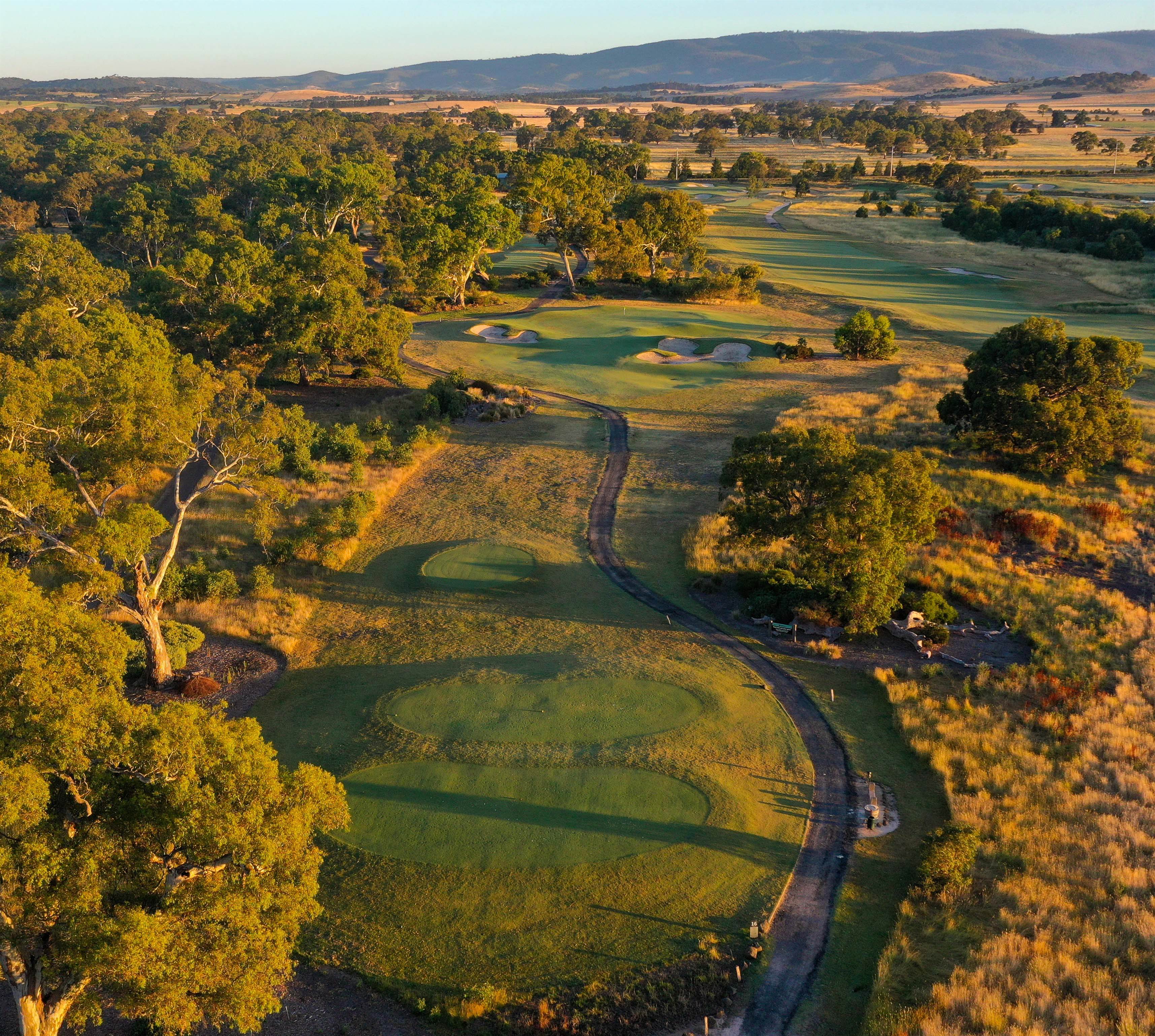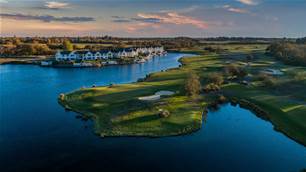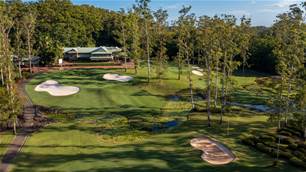New management and passionate staff with a firmly held view of sustainable golf practices has led to dramatic improvements at the course known by regulars simply as ‘The Frog’.
Here’s an interesting thing. If we were to consider designing a course to meet the needs of the future, we could do well to hark back to a course that opened almost 17 years ago.
Growling Frog is its name, and that’s a good start. Compelling and creative. That’s Marketing 101 right there. But it’s genuinely appropriate, too, named after the Growling Grass Frog, which is native to the Whittlesea area and in sore need of some support if he/she is to survive current endangered classification.
Sustainability in golf, both in greenkeeping and in environmental responsibility, is an issue stretching into the future – largely due to less than perfect practices of the past – and Growling Frog is ahead of the game on that score.
Then there’s the role that public courses play in both development of the game and in drawing a community together.
There’s the difference that an experienced, organised management approach can make to a club that is struggling.
There’s the enthusiasm and vision for the future that vibrant staff can add.
And, while it may seem at first a small point, there’s the use of tees that are based on ability rather than gender, a major influence in players of all standards having an equal opportunity to enjoy their game. Surely that’s the ultimate aim?

It was in the eyes of the Whittlesea Council which controls the land, traditionally owned by the Wurundjeri Willum Clan. Council set aside around 300 acres for the specific purpose of building a course for residents and ratepayers to enjoy.
And it was in the eyes of its designer, the respected Graham Marsh, when he first surveyed the land in 2001. He set about creating a course that would challenge beginners and serious golfers alike, and he has succeeded.
At 6,185 metres for the back Blue Course, through 5,565m for the intermediate Yellow Course to 5,328 for the forward Red Course (all at par-72), it has enough length for the long hitters but strategically placed hazards, thought-provoking doglegs, uphill and downhill shots, and undulating greens bring those with excellent shot-making or crafty course management skills into the picture.
The quick way to sum up Growling Frog is that it has no weak holes. Every hole has its own interest and its own test of golfing resources.
The relatively short par-4 opener requires the golfer to immediately find his or her groove. A drive less than 200 metres from the back tees or 150 metres from the front - especially if it wanders towards the right side of the fairway - will mean a blind shot to the green or a strategic lay-up. The last part of the fairway is sharply downhill and veers to the right to add to the challenge. A visit to the downhill driving range to get the eye in is therefore recommended pre-round.

Resolve is further tested by the par-3 2nd hole. Guarded by greenside bunkers on the left and the right side of the green leaning towards a swale, accuracy, correct club selection and decent shot execution are key.
From here you are on your way.
The course winds its way through undulating land dotted with River Red Gums and dramatic white-barked Candlebark and Manna gums. The Whittlesea area is home to around 18 species of eucalypts and the Red River Gum, in particular, is protected by Council policy.
Many of these trees pre-date European settlement, estimated to be anywhere between 200-800 years of age, and have significant value in Indigenous history and culture, as well as their old, deep hollows providing a vital nesting space for a number of bird types.
There are stands of these magnificent trees adorning the majority of holes, particularly at the extremities of the two nine-hole loops, between holes 3 through 8 and then 13 to 16.
Throughout, there is an overwhelming sense of calm and serenity, helped no doubt by the scale of the course but also the fact that it is not bordered by housing. No more than farm fencing is encountered, other than a charming stone wall bordering the neighbouring property along the 16th and 17th holes.
With just the sound of birds and insects to accompany you (other than the thwack of club on ball), it is easy to feel a long way from civilisation. Some of the longer walks between green and tee reinforce this sense of tranquillity. Yet all this is just 30km north of the Melbourne CBD.
“Throughout, there is an overwhelming sense of calm and serenity, helped no doubt by the scale of the course but also the fact that it is not bordered by housing.”
Par-3s always seem to make or break a player’s score and Growling Frog has an excellent collection. After that testing 2nd hole, the 5th is a lovely short one-shotter with water running along the left, though not in play (although anything is possible hit poorly enough).
On the back nine, the 12th is interesting. There are no greenside bunkers to capture an errant ball but take it for granted at your peril. Making the green is one thing; making the putt (whether that be the first, second or, worse, the third) is another.
The 16th is part of a superb sequence of finishing holes. The longest of the par-3s, it goes without saying that a well struck tee shot is essential. Without that, only good bunker play, good chipping and putting can save your score.
The penultimate 17th hole is one of those great holes in golf – the short par-4 which demands strategy. Fabulous.
And then the finisher, the dogleg left and uphill 18th. This is a majestic hole, one that gets steeper as you get closer to the green, and one that has you thinking to the end. Final putt drained, take the time to turn around and just drink it all in again.
From there it’s to the clubhouse where spike bar and restaurant area afford stunning 180-degree views over the course and to the Great Dividing Range. The clubhouse is a modern building, well facilitated, and sits well in its landscape. A great place to reflect and to enjoy.
But what of the other elements that add to ‘The Frog’ experience? Let’s start with the frog itself. Endangered as it may be, this tailless amphibian is not without hope.
In 2019, the Victorian Government established the Biodiversity Conservation Strategy for Melbourne’s Growth Corridors, the masterplan of which acknowledges that the burgeoning population in Victorian growth areas such as Whittlesea – potentially a great resource for getting more people to play golf – must not come at the cost of destroying or interfering with natural biodiversity.

As a sign of its early commitment to conservation, Growling Frog was the first course built in Australia using 3D and GPS tracking technologies, meaning environmentally sensitive areas and existing trees were protected during course construction.
Happily, The Frog is home to a few of its eponymous creatures – you can either see or hear them in the rocks behind the 15th and 16th holes and in other wetland areas around the course, while a fenced off area around the 11th and 12th holes protects works in progress to restore native grasses and wildflowers. Aside from encouraging native flora, this area will help create an ideal habitat for the Growling Grass Frog (pictured) and mates.
For those keen on wildlife, there are also kangaroos, ducks, wedge-tails and other birdlife, rabbits and even a wombat or two. There are apparently snakes, too, but maybe give those a wide berth.
The biggest improvement at Growling Frog in the last year is in its management structure. It was open knowledge in golf that Whittlesea council was losing money running the course but its decision to lease it to Golf Services Management (GSM Golf) for an initial five-year period from July 2019 was a coup for both parties.
Growling Frog received a much-needed injection of golf management expertise and GSM a great fit with the other Victorian courses in its portfolio – St Andrews Beach, Ranfurlie, Morack and Bay Views.
Under the guidance of GSM’s Scott Eduarti and Operations Manager Mal Jebb, Growling Frog has instituted a number of great moves resulting in a more streamlined process and professional attitude without compromising the informal nature of the place.

One of these changes was to engage Programmed Turnpoint to oversee its course maintenance and agronomy, which was an excellent step. With it came course superintendent Nathan Turner, whose commitment to his course borders on obsessional. Turner arrived following a stint as assistant superintendent at Portsea Golf Club and as a graduate of the highly regarded Ohio State University International Turfgrass Program.
As an intern, he honed his craft at such courses as Congressional (its Blue Course has hosted five US majors), Kirtland Country Club and The Club at Mediterra, which has two Tom Fazio-designed courses.
Prior to that he had apprenticed at Horsham before working at clubs such as The National, New South Wales, Sanctuary Lakes and Hamilton Island.
Course management philosophy in Australia leans towards plant health rather than the use of fungicides and pesticides and Turner incorporates what he calls cultural practices into Growling Frog – dusting, sand, aeration and soil applications to keep the soil in the best condition to hold onto supplied nutrients.
Recycled water is used throughout the course, which has Santa Ana couch fairways and A-1 bentgrass greens. With a clay and rocky soil base, drainage is a potential problem but work done to improve this after an above-average year of rainfall in 2020 has led to significant improvement.
Drainage works are planned to continue through 2021, along with continued bunker refurbishment. The course is currently a picture of brilliant health but Turner is keen to bring it to an even higher level again.

Such is his passion for Growling Frog that Turner hand-made each of the tee markers for the blue, yellow and red courses from recycled local timber.
And there’s a line-up of talent in the pro staff. One of the teaching professionals, Tim Wood, was named the Victorian Coach of the Year at the 2020 Vic PGA State Vocational Awards. Wood’s students have included 2018 Vic Open champion Simon Hawkes, 2019 NSW Open winner Josh Younger and experienced Tour pro Terry Pilkadaris. He is ably supported by Jack Cox.
Tee times are now eight minutes apart to reduce congestion and, the biggest change of all, 95 percent of players book for their round rather than just rock up. Before the arrival of GSM this was closer to 60 percent.
The effect is best seen in the stats. Despite the effects of COVID-19 and Melbourne lockdown, rounds are up by 150-200 players per week compared to the same period in 2019.
It doesn’t end there either. GSM plans to further increase those rounds, encouraging junior and female participation and growing its two member clubs – the co-gender Growling Frog Golf Club and the Growling Frog Ladies Golf Club.
The Frog is also very popular with social groups, a hugely growing part of modern golf, and it’s not hard to see why. Social golf clubs make up around 21 percent of all Australian member golf clubs and that doesn’t take into account casual players.
Public golf courses such as Growling Frog, on which social clubs and golfers play, are therefore a key component in the Australian golf landscape. They can be either a pathway for new golfers to ‘traditional’ bricks-and-mortar club membership or they can be a destination in themselves for those who prefer the informality, the value price and the relaxed dress code.
One of the reasons Whittlesea council originally turned over land for a golf course 20 years ago was to serve its community. It seems that with interest high from visitors as well as locals that the original intention is finally being served, and then some.
Growling Frog’s time has arrived.
FACT FILE
LOCATION: 1910 Donnybrook Road, Yan Yean, Vic. 3755.
CONTACT: (03) 9716 3477.
WEBSITE: www.growlingfroggolf.com.au
DESIGNER: Graham Marsh (2004).
PLAYING SURFACES: Santa Ana couch fairways, A-1 bentgrass greens.
OPERATIONS MANAGER: Mal Jebb.
COURSE SUPERINTENDENT: Nathan Turner.
PGA PROFESSIONALS: Tim Wood and Jack Cox.
GREEN FEES: $50 (18 holes), $45 online. $32 (9 holes). See website for group, local resident and other discounts. GSM season passes $49 enable golfers to access discounted rates at their six courses across Australia.
MEMBERSHIP: A number of different season passes are available with an option of monthly payment options. Resident Clubs – Growling Frog GC, Growling Frog Ladies GC and GSM GC. Members pay a small annual fee for golf league affiliation, insurance and club administration and then pay for play with priority tee times.
FACILITIES: Restaurant, Café, Spike Bar, Driving Range.
ACCOLADES: Ranked No.78 in Golf Australia magazine’s Top-100 Public Access Courses for 2021 – a dramatic jump of 17 spots from its 2019 ranking.
Related Articles

Course Review: Cape Kidnappers

Review: Clearwater Golf Club



.jpg&h=115&w=225&c=1&s=1)




_15th_hole.jpg&h=115&w=225&c=1&s=1)




